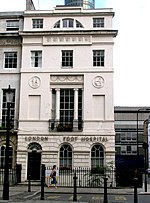BT Tower

The BT Tower is a grade II listed communications tower located in Fitzrovia, London, owned by BT Group. It was also known as the GPO Tower and the Post Office Tower. It was later officially renamed the Telecom Tower. The main structure is 581 feet (177 m) high, with a further section of aerial rigging bringing the total height to 620 feet (189 m).Upon completion in 1964, it overtook the Millbank Tower to become the tallest structure in London until 1980, when it in turn was overtaken by the NatWest Tower. It was opened in 1965 by Prime Minister Harold Wilson who viewed it as a monument of a Britain shimmering in the "white heat of technology". A 360° coloured LED screen is located near the top of the tower—making it a conspicuous presence on the London skyline—which displays news events to the public across central London every day, including breaking news.
Excerpt from the Wikipedia article BT Tower (License: CC BY-SA 3.0, Authors, Images).BT Tower
Cleveland Street, London Fitzrovia (London Borough of Camden)
Geographical coordinates (GPS) Address Nearby Places Show on map
Geographical coordinates (GPS)
| Latitude | Longitude |
|---|---|
| N 51.5215 ° | E -0.1389 ° |
Address
BT (Bloomsbury Telephone Exchange)
Cleveland Street 60
W1T 4JZ London, Fitzrovia (London Borough of Camden)
England, United Kingdom
Open on Google Maps








